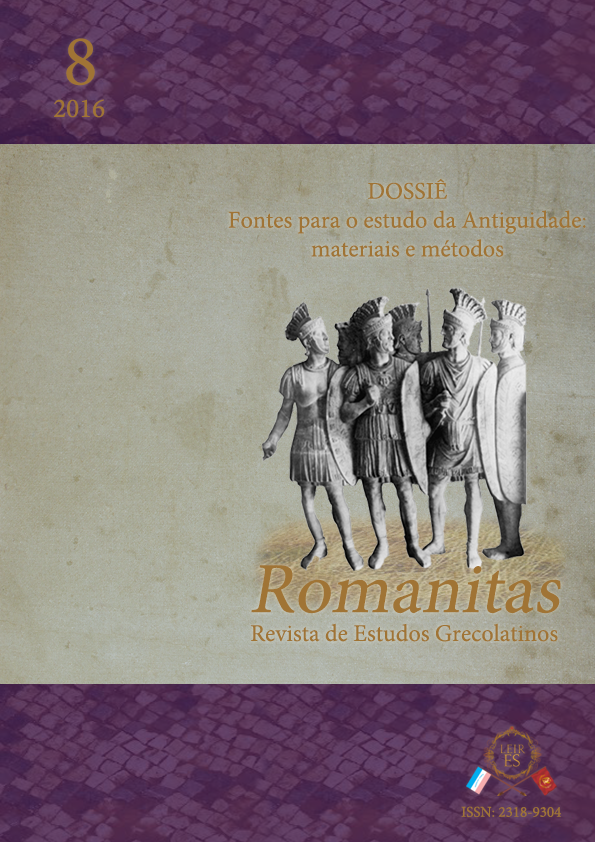As 'Ogham Stones': fontes para o estudo da 'Hibernia' e da 'Britannia romana' (e pós-romana)
DOI:
https://doi.org/10.17648/rom.v0i8.15164Palavras-chave:
Fontes, Antiguidade, Ogham Stones, Hibernia, Britannia romana, Britannia pós-romanaResumo
Uma das principais transformações ocorridas no campo historiográfico desde a constituição da História como uma ciência (Geschichtswissenschaft) foi a ampliação da noção de documento, que deixou de ser compreendido apenas como texto escrito para englobar qualquer indício da presença humana. Assim como outras áreas, a História Antiga também acompanhou estas mudanças, o que permitiu uma renovação das fontes, dos materiais e dos métodos para o estudo da Antiguidade. O objetivo deste artigo é apresentar algumas questões sobre um corpus documental pouco trabalhado pela historiografia brasileira, as Ogham Stones, fontes importantes da cultura material para o estudo da Hibernia e da Britannia romana (e pós-romana).Downloads
Referências
ADAMS, J. N. Bilingualism and the Latin language. Cambridge: Cambridge University Press, 2004.
BRUUN, C.; EDMONDSON, J. The Oxford handbook of Roman epigraphy. Oxford: Oxford University Press, 2015.
CARNEY, J. Early Irish literature: the state of research. International congress of celtic studies, p. 128-130, 1983.
______. The invention of the Ogom cipher. Ériu, v. 26, p. 53-65, 1975.
CHARLES-EDWARD, T. M. Early Christian Ireland. Cambridge: Cambridge University Press, 2000.
CLARKE, R. R. An Ogham inscribed knife-handle from South-West Norfolk. The Antiquaries Journal, v. 32, p. 71-73, 1952.
CONNELLY, C. J. A partial reading of the Stones: a comparative analysis of Irish and Scottish Ogham pillar stones. Thesis – University of Wisconsin, Milwaukee, 2015.
DAVIES, W.; GRAHAM-CAMPBELL, J. CISP – Celtic Inscribed Stones Project, 1999. Disponível em: <http://www.ucl.ac.uk/archaeology/cisp/database/>. Acesso em: 30 jul. 2016.
DI MARTINO, V. Roman Ireland. London: The Collins Press, 2003
FORSYTH, K. S. The Ogham inscriptions of Scotland: an edited corpus. Thesis – Harvard University, Harvard, 1996.
FREEMAN, P. Ireland and the Classical World. Houston: University of Texas Press, 2001.
FULFORD, M.; HANDLEY, M.; CLARKE, A. An early date for Ogham: the Silchester Ogham stone rehabilitated. Medieval Archaeology, v. 44, p. 1-23, 2000.
HARVEY, A. The Ogham inscriptions and the Roman alphabet: two traditions or one? Archaeology Ireland, v. 4, n. 1, p. 13-14, 1990.
HINGLEY, R. Hadrian’s Wall: a life. Oxford: Oxford University Press. 2012.
MAC COITIR, N. The Ogham alphabet: a military origin? Archaeology Ireland, v. 26, n. 1, p. 22-25, 2012.
MACALISTER, R. A. S. Corpus Inscriptionum Insularum Celticarum. Dublin: Stationery Office, 1945/1996.
MAcMANUS, D. A guide to Ogam. Maynooth: An Sagart, 1991.
MONTGOMERY, G. The ancient origins of sign handshapes. Sign Language Studies, v. 2, n. 3, p. 322-334, 2002.
MOORE, F. The Ogham stones of County Kerry. In: MURRAY, G. Medieval treasures of County Kerry. Kerry: Walsh Colour Print, 2010, p. 6-18.
NASH-WILLIAMS, V. E. The early Christian monuments of Wales. Cardiff: University of Wales, 1950.
NÍ BHROLCHÁIN, M. An introduction to early Irish literature. Dublin: Four Courts Press, 2009.
Ó CRÓINÍN, D. Early medieval Ireland 400-1200. London: Longman, 1995.
OKASHA, E. Corpus of early Christian inscribed stones of South-West Britain. Leicester: Leicester University Press, 1993.
RAFTERY, B. Ireland: a world without the Romans. In: GREEN, M. J. The Celtic world. London: Routledge, 1996, p. 636-653.
ROCHE, J. The influence of Ireland on Roman Britain cursus unicus? Archaeology Ireland, v. 7, n. 1, p. 7-9, 1993.
ROWE, G. Epigraphical cultures of the Classical Mediterranean: Greek, Latin and beyond. In: ERSKINE, A. (Ed.). A companion to ancient history. Chilchester: Wiley-Blackwell, 2009, p. 23-36.
SANTOS, D. A cultura Hiberno-latina na Bretanha romana e pós-romana: evidências a partir das Ogham Stones. Anais eletrônicos do XXVIII Simpósio Nacional de História, 2015. Disponível em: <http://www.snh2015.anpuh.org/resources/anais/39/1434321851_ARQUIVO_Aculturahiberno-latinaversaofinal.pdf>. Acesso em: 10 jun. 2016.
______. How the historical Patrick was transformed into the St. Patrick of religious faith. New York: The Edwin Mellen Press, 2013.
SCHAPS, D. M. Handbook for classical research. New York: Routledge, 2011.
STEVENSON, J. The beginnings of literacy in Ireland. Archaeology, Celtic Studies, History, Linguistics, Literature, v. 89, p. 127-165, 1989.
THOMAS, A. C. And shall these mute stones speak? Post-Roman inscriptions in Western Britain. Cardiff: University of Wales Press, 1994.
______. Irish colonists in South-West Britain. World Archaeology, v. 5, n. 1, p. 5-13, 1973.
THURNEYSEN, R. A. A grammar of old Irish. Dublin: DIAS, 2003.
VANDERBILT, S. Roman inscriptions of Britain (RIB). Disponível em: <http://romaninscriptionsofbritain.org/>. Acesso em: 30 jul. 2016.
WHITE, N. Ogham in 3d project, 2012. Disponível em: . Acesso em: 30 jun. 2016.
WOOLF, G. Literacy or literacies in Rome? In: JOHNSON, W. A.; PARKER, H. N. (Ed.). Ancient literacies: the culture of reading in Greece and Rome. New York: Oxford University Press, 2009, p. 46-68.
Downloads
Publicado
Como Citar
Edição
Seção
Licença
Copyright (c) 2017 Romanitas - Revista de Estudos Grecolatinos

Este trabalho está licenciado sob uma licença Creative Commons Attribution-NonCommercial-NoDerivatives 4.0 International License.
a. Os autores mantêm os direitos autorais e concedem à revista o direito de primeira publicação.
b. Os autores têm autorização para assumir contratos adicionais separadamente, para distribuição não-exclusiva da versão do trabalho publicada nesta revista (ex.: publicar em repositório institucional ou como capítulo de livro), com reconhecimento de autoria e publicação inicial nesta revista.
c. Autores têm permissão e são estimulados a publicar e distribuir seu trabalho online (ex.: em repositórios institucionais ou na sua página pessoal) após a primeira publicação pela revista, com os devidos créditos.
d. Os textos da revista estão licenciados com uma Licença CC BY 4.0 Deed Atribuição 4.0 Internacional (CC BY).




























